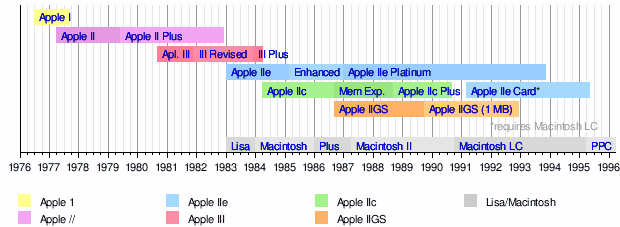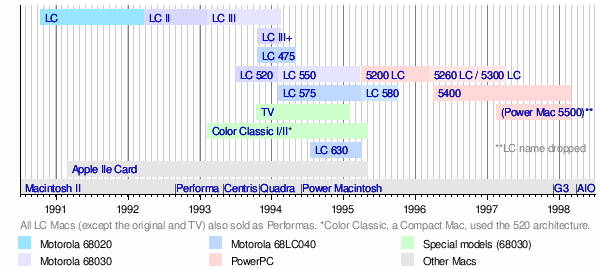Apple IIe Card

The Apple IIe Card (Apple Computer part #820-0444-A) is a compatibility card which allows compatible Macs to run software designed for Apple II computers (except the 16-bit Apple IIGS). Released in March 1991 for use with the LC family of Macintosh computers, Apple targeted the card at its widely dominated educational market to ease the transition from Apple II-based classrooms, with thousands of entrenched educational software titles, to Macintosh-based classrooms.
Features
Like the Apple IIe itself, the Apple IIe Card uses an onboard 65C02 CPU. The CPU is software-configurable to run at the Apple IIe's native 1.0 MHz speed or at an accelerated 1.9 MHz. Video emulation (text and graphics) was handled through software using native Macintosh QuickDraw routines, which often resulted in operations being slower than a real Apple IIe except on higher-end machines. Any Macintosh that supports the card can be switched into 560×384 resolution for better compatibility with the IIe's 280×192 High-Resolution graphics (essentially doubled on the Macintosh). This was particularly applicable to the Color Classic which was otherwise fixed at 512×384 resolution.
The host Macintosh emulates, or provides native access to many of the expansion cards and peripherals one might install in a bare Apple IIe. These services provided to the IIe card makes the simultaneous running of the host's OS 7.x.x impossible. Hardware services include a 1.44 MB 3.5" SuperDrive, mouse, 1 MB RAM, 80-column text and graphical monochrome or color display, clock, numeric keypad, two hardware serial ports (in addition to the emulated serial necessary for the IIe mouse), SCSI hard drive, and AppleShare file server. An included "Y-cable" enables the attachment of up to two external 140 KB floppy disk 5.25" Drives, an 800 KB "intelligent" 3.5" UniDisk drive, and a joystick or paddle control for use with the hard-coded Apple IIe emulator. 800 KB 3.5" Drive and 1.44 MB SuperDrives are not recognized when attached via the Y-cable due to the Disk Controller on the IIe card lacking support. (chip labeled U1A located in zone A1 of card - lower left as pictured above)
The product included an owners manual, Y-cable, and 2 disks: the Apple IIe installer disk and the Apple IIe card startup disk. 2.2.2d1 is the latest version of the startup disk. Version 2.2.1 and a patch to reach 2.2.2d1 are available at Apple Support Area.
Technical specifications
- Mega II ("Gemini" chip); a complete Apple IIe on chip minus RAM, firmware and CPU
- IWM (Integrated Woz Machine); floppy control functions
- 256 KB RAM built-in (128 KB for Apple II memory, 128 KB reserved for Macintosh)
- 65C02 processor running at either 1.023 MHz or 1.9 MHz
- High-density 26-pin connector with "Y-cable" supports joystick/paddles and two Apple 5.25" or UniDisk 3.5" floppy disk drives
- Ability to access up to 1 MB of native Macintosh RAM
- All Apple IIe text and video modes supported, via QuickDraw software emulation
Notes: When emulating an Apple IIe, only a full-screen mode is available and all native Macintosh functions are suspended while running. A graphical control panel is available for configuring the virtual Apple II slots and peripherals; however, the Macintosh (as well as Apple IIe emulation) still remains suspended during this activity. Macintosh functions and control resume only once emulation is completely shut down and exited.
Host system compatibility
The card plugs into the PDS slot in many of the LC-series Macintoshes, but not all models and system software combinations are supported. Apple's Tech Info Library article #8458 lists the following models as Apple IIe Card-compatible: Color Classic, LC, LC II, III & III+; LC 475, 520, 550, 575; Quadra 605 and Performa 4XX, 52X, 55X, 56X, and 57X. However, other models that have an LC-compatible PDS slot and support 24-bit memory addressing are compatible with the Apple IIe Card but are not officially supported. Systems 7.0 through 7.5.5 support both 24- and 32-bit addressing on suitable Macintosh models. (From System 7.6 onwards, Macintosh system software does not support 24-bit addressing.) To enable 24-bit addressing on supported systems, use the Macintosh Memory control panel.
Timeline of Apple II family models

Timeline of Macintosh LC models

See also
External links
- Apple IIe Card FAQ
- Using an Apple IIe Card in Your Macintosh
- Macintosh Compatibility Table
- Comm Slot Compatibility